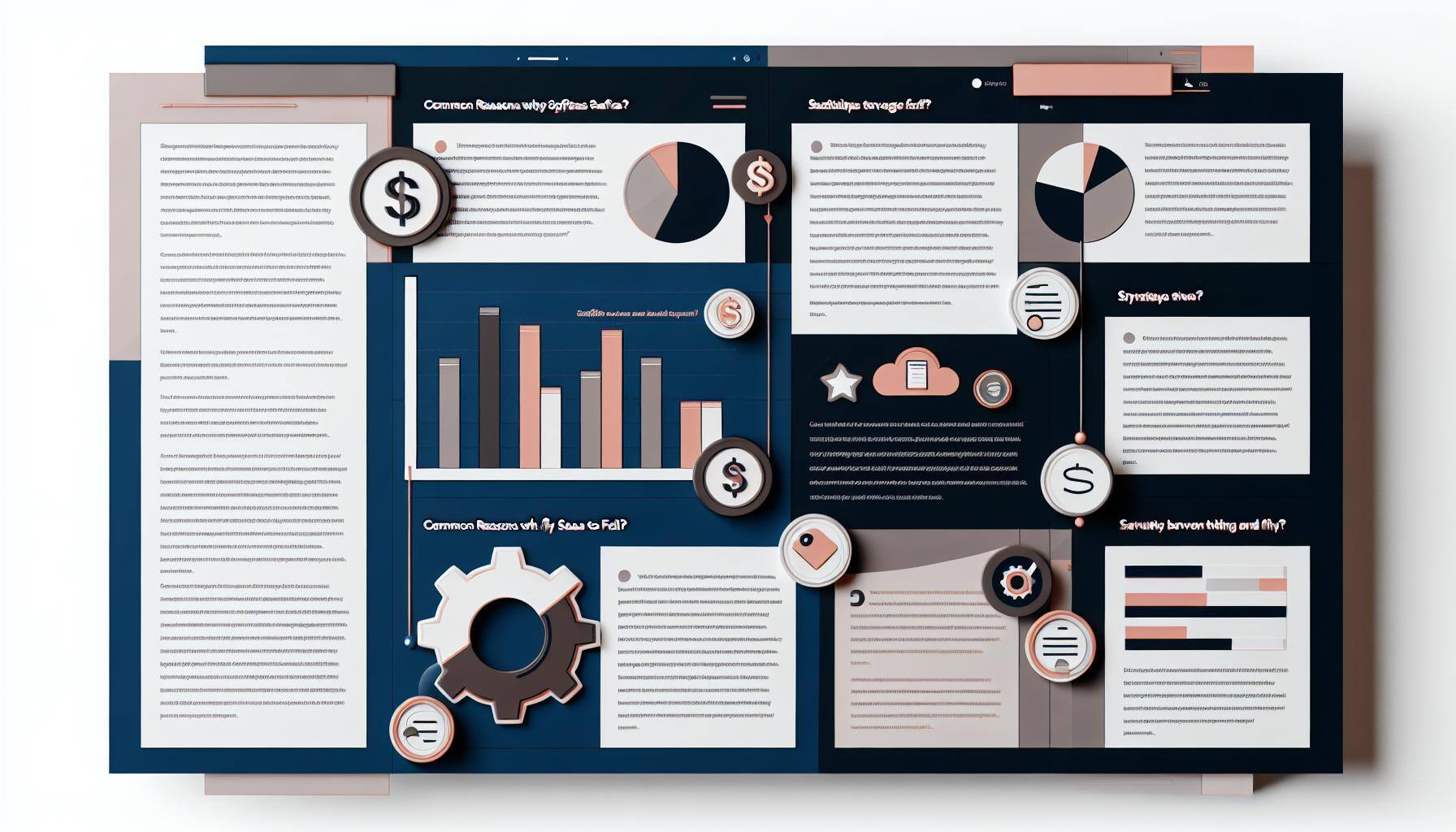Building a Successful B2B SaaS Company: A Founder’s Journey
Building a Successful B2B SaaS Company: A Founder’s Journey Starting and nurturing a B2B SaaS company is a journey that combines innovation,...
6 min read
Brian Polackoff
:
Jun 19, 2024 1:27:00 PM

Software as a Service (SaaS) startups have been booming in recent years due to the increasing demand for cloud-based solutions. However, not all ventures in this industry make it to success. Understanding the factors that contribute to the failure of SaaS startups is crucial for entrepreneurs looking to establish a successful SaaS business.
Challenges in the SaaS industry can pose significant obstacles for SaaS startups. The competitive SaaS market requires innovative solutions and efficient execution to stand out amidst numerous SaaS companies offering similar products or services. Additionally, the impact of poor business models can lead to financial difficulties and hinder overall growth. Market research plays a pivotal role in identifying gaps in the SaaS market and ensuring that SaaS startups are catering to the needs of their target audience effectively.
Managing customer churn is indeed a crucial aspect of a SaaS startup's success. Strategies such as providing exceptional customer support and continuously improving products are vital. Let's delve deeper into various strategies and actions that can help reduce customer churn and ensure the growth and stability of a SaaS business:
1. Understanding Customer Churn: First, it's imperative to understand why customers leave. This involves collecting and analyzing data related to customer exits. Tools and surveys can be vital in gathering this information. Understanding the reasons behind churn can inform more targeted strategies to prevent it.
2. Exceptional Customer Support
Accessibility: Ensure that support is easily accessible through multiple channels (e.g., chat, email, phone).
Responsiveness: Quick responses can prevent frustration. Aim for rapid initial responses and set clear expectations for resolution timelines.
Personalization: Tailor support to individual customer needs. Personalized attention can increase customer loyalty and satisfaction.
3. Continuous Product Improvement
Feedback Loop: Actively seek, listen to, and incorporate customer feedback into product development. This shows customers that their input is valued and leads to improvements that reduce churn.
Feature Updates: Regularly update the product with new features and improvements, communicating these updates to customers to keep them engaged and aware of the product's value.
4. Customer Education and Onboarding: A comprehensive onboarding process educates customers on the best way to utilize your product, thereby increasing their success and satisfaction. Continuous education through webinars, tutorials, and documentation helps customers get the most out of your service, making them less likely to leave.
5. Proactive Customer Engagement
Customer Success: Invest in a customer success team that proactively reaches out to customers, especially those showing signs of disengagement or dissatisfaction.
Regular Check-ins: Scheduled calls or meetings can help address any concerns before they lead to churn, thus enhancing customer retention.
6. Utilizing Customer Feedback: Customer feedback is gold. Implement a systematic approach to solicit, analyze, and act on customer feedback. This can uncover areas for improvement and aspects of your service that customers appreciate.
7. Offering Customizable Plans: Flexibility can be key in retaining customers. Offering customizable plans or services that can scale with your customers' needs helps ensure they don't leave for a more fitting solution.
8. Building a Community: Fostering a community around your product or service can increase loyalty. Customers who feel they are part of a community are less likely to churn and more likely to become advocates.
9. Predictive Analytics: Using predictive analytics to identify at-risk customers before they churn allows for targeted retention efforts, potentially saving a significant number of customer relationships before they dissolve.
Implementing these strategies requires a balanced approach, often tailored to the unique aspects of a SaaS startup's product and customer base.
Learning from successful SaaS companies can offer valuable insights into the SaaS business landscape. Understanding common mistakes to avoid and the importance of continuous innovation can help SaaS startups navigate potential challenges effectively. Implementing a culture of innovation and striving for product-market fit are key strategies for SaaS startups to differentiate themselves in a competitive market.
The impact of poor product launches can significantly affect the SaaS success rate of companies. Properly identifying the target market and implementing effective pricing strategies for SaaS products are crucial steps in ensuring the sustainable growth of SaaS businesses. Failing to address these aspects can lead to SaaS startups missing out on opportunities for growth and expansion. Software as a Service (SaaS) companies have transformed the way businesses operate, offering scalable, cloud-based applications with flexible pricing models. However, despite the potential for high revenue and growth, a significant number of SaaS startups struggle to survive. Common reasons for the failure of SaaS companies include:
1. Lack of Market Need: Many SaaS startups develop a product without thoroughly researching whether there's a real demand for it. Innovating a solution that doesn’t solve a significant problem for a substantial target audience is one of the root causes of failure.
2. Poor Product-Market Fit: Even if the product addresses a genuine need, it must also resonate with its target market. Failure to achieve a good product-market fit - where the product meets the specific needs and expectations of its intended users - can lead to low adoption rates and churn.
3. Ineffective Pricing Strategy: A contributing factor to the challenges faced by many start-ups in establishing a successful SaaS model. Pricing a SaaS product too high can deter potential customers, while pricing it too low might not generate enough revenue to sustain the business. Finding the right balance, understanding the value proposition, and adapting a pricing strategy that meets market demand is crucial.
4. Inadequate Customer Understanding and Retention: Not understanding the customer’s journey, ignoring customer feedback, and not investing in customer success can lead to high churn rates. Retaining customers in the SaaS business model is as crucial as acquiring new ones, if not more so.
5. Underestimating the Competition: The SaaS industry is highly competitive. Failing to differentiate the product or service from competitors can make it difficult for a new entrant to carve out a market share. It’s vital to have a unique value proposition and continuously innovate.
6. Lack of Effective Marketing: Many SaaS startups overlook the importance of a solid marketing strategy. Understanding the channels through which their target customers can be reached and engaged with is critical. Without effective marketing, even the best product can remain unnoticed.
7. Scaling Too Quickly or Too Slowly: Finding the right pace for scaling operations is a delicate balance. Scaling too quickly can exhaust resources and lead to unmanageable growth, while scaling too slowly may result in missed opportunities and allowing competitors to capture market share.
8. Cash Flow Mismanagement: Efficiently managing cash flow is crucial for the survival of any startup. Many SaaS companies fail because they burn through their capital too quickly without having a clear path to profitability or because they underestimate the importance of recurring revenue stability, leading to harsh consequences for their chances of success.
9. Not Having the Right Team: The importance of a committed, skilled, and cohesive team cannot be overstated. From technical expertise to sales and customer service, every aspect of the business must be covered by competent individuals who share the vision of the company.
10. Technical Issues and Downtime: For a SaaS company, uptime is critical—any significant downtime can lead to loss of customers and damage to reputation. Investing in robust infrastructure and ensuring there is a capable technical support
Strategies to improve cash flow and manage financial difficulties are imperative for SaaS startups to sustain their operations in the long run. Leveraging effective marketing strategies to reach and engage the target audience can play a vital role in the success of SaaS businesses. Implementing new features and enhancements based on customer feedback and market trends can help SaaS startups stay relevant and competitive in the ever-evolving SaaS market. Avoiding product failure in SaaS startups demands a multi-faceted approach that encompasses financial planning, market understanding, customer engagement, continuous product development, and a focus on customer retention. Here's a guide to navigate these waters successfully:
1. In-depth Market Research
Understanding the market is foundational for reducing the chances of success for a SaaS startup. Conduct in-depth research to identify your target customers, understand their needs, pain points, and how your product can address those. Analyzing competitors helps to position your product uniquely.
2. Customer-Centric Development
Feedback Loop: Implement a robust system to gather, analyze, and act on customer feedback regularly. This ensures your product evolves in alignment with users' needs.
Customer Support: Exceptional customer support can differentiate your SaaS product. It helps in retaining customers and getting constructive feedback.
3. Focused Financial Planning
Budget Management: Keep a close eye on your burn rate. Prioritize spending on activities and resources that directly contribute to product growth and customer satisfaction.
Revenue Streams: Explore various pricing models and revenue streams, such as subscription-based models, freemium models, or tiered pricing strategies, to find what best suits your market and product.
Funding and Cash Reserves: Plan your funding rounds wisely and maintain cash reserves to weather unforeseen financial challenges.
4. Effective Marketing and Sales Strategies
Value Proposition: Clearly communicate the unique value your product brings. Ensure your marketing messages resonate with your target audience.
Content Marketing: Invest in content marketing to educate your potential customers about your product and the problems it solves.
Sales Channels: Optimize your sales channels. Whether it's direct sales, partnering with resellers, or an inside sales team, find the most effective channels for your product.
5. Agile Product Development
Iterative Development: Be prepared to pivot or iterate based on market feedback and changing market conditions. Agile development allows for flexibility and rapid adjustments.
Innovation: Regularly update your product with new features and enhancements to stay ahead of the competition. However, ensure these updates are driven by customer needs and strategic vision, not just technology trends.
6. Strategic Partnerships: Forming strategic partnerships can help in extending your product’s reach, enhancing its capabilities, or even tapping into new customer segments.
7. Quality Assurance: Maintain high standards of quality for your SaaS product. Ensure thorough testing and bug fixing to provide a seamless user experience.
8. Culture of Learning and Adaptation: Foster a culture that encourages learning from mistakes and adapting. The SaaS industry is fast-paced, and the ability to quickly learn from what didn't work and pivot accordingly is critical.

Building a Successful B2B SaaS Company: A Founder’s Journey Starting and nurturing a B2B SaaS company is a journey that combines innovation,...

In the highly competitive B2B SaaS market, churn rate is more than just a key performance indicator for your management team—it's a crucial metric...

For your Software as a Service (SaaS) company, churn—the rate at which customers discontinue their subscriptions—is a critical health metric. Since...